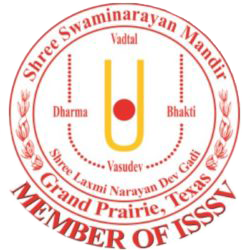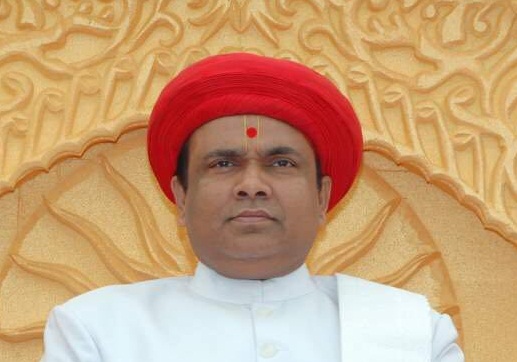The Lord manifested himself at the household of Dharmedev and Bhaktimata in the Indian calendar year of V.S 1837. Lord Swaminarayan is the form of Parm-Atma (supreme soul) and his reasons for incarnating in a human form were portrayed throughout his life. Swaminarayan Bhagwan re-established all aspects of true Vaishnavism and at the time of his manifestation, it proved extremely necessary. Through a span of over 49 years the Lord accomplished all the tasks he aimed to complete and many more. Swaminarayan Bhagwan left His human body in the year V.S 1886 and will always remain as Vasudev (the one that resides in everything and in what everything resides in).
What does Swaminarayan mean?
The Meaning of Swaminarayan as a mantra is:
- ‘Swami’ means: Sarvana niyanta(leader of all)
- ‘Narayan’ means: Naranam ayanam – darek ni andar rahela (the one that resides in all) Samagra duniya ne jetal sthir ashitr padarth ni andar rahela antaryami pane, darek na adhisthata.
This mantra was given by the Lord himself to his followers as the Maha Mantra in Faneni village on the 14th day after Ramanand Swami departing to the Lord’s abode. For a Mantra to be classified as Maha it means that it is the ultimate one and only main mantra.
Why do Swamis wear orange?
As a standard rule in the Dharma of Swami’s, they are required to wear only orange color material. This color is called Bhagwa and is considered a spiritual color as it has relation to Bhagwan. Bhagwan color is one of no value therefore fits well with a Tyaagi (detached) life. Also called Gheru rang. From time immemorial orange color has been used to distinguish saints and ascetics.
What is a Sampraday?
The term Sampraday represents a fellowship body of devotees. It is an establishment on the basis of a Samp (togetherness).
When did the Uddhav Sampraday start?
Ramanand Swami had divine Darshan of Lord Shree Krishna in Vrindavan and was told by Lord that I will be taking an incarnation in the near future. Swami was ordered to gather True saints and Devotees and start a Sampraday. This Sampraday was to be known as the Uddhav Sampraday after its founder Ramanand Swami, the incarnation of Uddhavji. The Sampraday was started initially before the birth of Swaminarayan Bhagwan during the initial preaching activities of Ramanand Swami.
Why do we have Swamis?
There is a great emphasis on the importance of Swami’s. Saints live a Tyaagi (dis-attached) life style and this overall proves to be beneficial in many ways. Swaminarayan Bhagwan has expressed many times how much he appreciated a saintly life. By the commandment of Swaminarayan Bhagwan Swami’s are require to preach the greatness of God and contribute to the Sampraday. Saints are important because they guide us away from maya, if there were no saints then who would guide us to the Lord.
Why do we have Acharyas?
In the Shikshapatri Swaminarayan Bhagwan states: For the protection of the Sampraday. Acharyas are necessary to keep the balance of Satsang. For any organization, we have leaders, Acharyas are the spiritual leaders for our sect. Swaminarayan Bhagwan was initiated as the spiritual successor of the Uddhav Sampraday, similarly when He departed to His abode, he left Acharyas in-charge of the Sampraday and hence Acharyas are our spiritual leaders. Lord also has mentioned that He resides in Acharyas.
Why did Bhagwan do the Vanvichran?
To give salvation to many souls. If he stayed at home then he would not be able to go to other devotees places to give them happiness. If he became king those ordinary people would not get Darshan, so he went out himself out of love for devotees.
Why do we do Danvat Pranam?
Dandavt Pranam comes under the Bhakti category: Vandanam, a form of surrendering to the Lord. I am all yours. There are two forms of Dandvat: Panchang & Shastang.
What is a Mala?
Mala inspires devotees to remember Shreeji Maharaj at least once a day especially when we remain busy with worldly affairs. It inspires us to roll Mala one, five or eleven times while worshiping Shreeji Maharaj. We derive satisfaction and confidence by doing so. The introduction of it was felt for chanting of mantra. As a result, devotees roll Mala and for easy counting the mantra, it came into existence. It is ideal for counting the recitation of mantra.
Origins of the Mala:
- Early days: Yogis used to push a few counted grain seeds (say 1000) in a plate-like vessel made of sticks joined with cowdung and purified with prasadi sindoor, by moving one seed across every time they said a Jap mantra. They then repeated this for a certain number of times in a day. (This seed method is still done today as a mode of doing Jap). This counting was not possible for the ordinary illiterate folk.
- A chain of seeds was finally made and ordinary folk obtained these from the Rushis. (That’s why we get Mala from Mandir and don’t buy from outside shops). But these seeds started getting dry and deformed over time especially when the Rushis were travelling.
- Rushis came up with beads, and most types of material used were, changing over time:
- Tamarind (amli) tree
- Dry lotus (kamal) seeds
- Rudraksh beads
- Reeds (darbh)
- Sandal wood (Sukhad)
- Tulsi wood
Why do we do Mala?
- “Kare jap to chhutte lap”. Jap is the best way to please the Lord and seek his assistance in solving our problems.
- Jap is most helpful in clearing the mind of impure conscience. It spreads positive vibes around you,and even cleanses the thoughts of those around you. When Chanakya Hrishi was doing jap, the wholevillage became tranquil.
- Jap is most powerful in clearing ‘antah-shatrus’ (kam, krodh, lobh, moh, matsar, irshya, kapat, ahankar, agnan, etc) for one to become ‘atma-chaitanya’.
- Jap helps us do dhyan of the Lord and by dhyan we attain the Lord, and with it salvation.
- Jap is part of Smaranam bhakti – thinking about the Lord.
In Bhagwat: Ajameil said (NOT recited) NARAYAN because he was calling his son, hence God came to improve his moksha and averted his definite Yampuri, BUT he did not get ultimate moksha as he had not met the other requirements.
How should we do mala?
In shikshaptri bhasya it is stated how to do Mala. Mala can be done in different ways and different time’s portray different Mala positions, such as to heart, nose, belly button. (you can find further verification in Shikshapatri Bhashya). The three ways to do Mala are:
- Uche saade- out loud
- Upamsu jap – chap phapde- Basic lip movement
- Mansik jap – full Mental concentration

